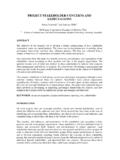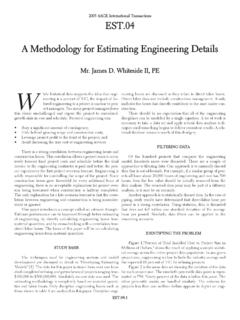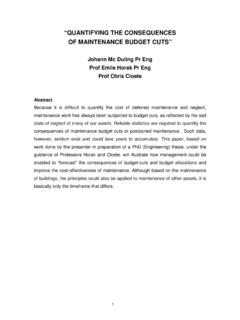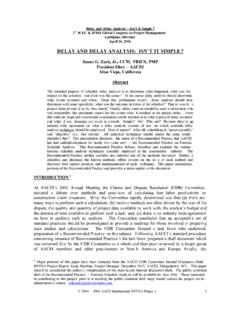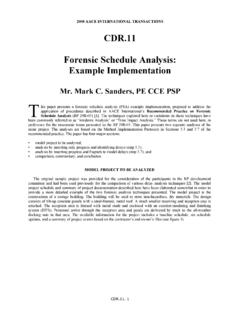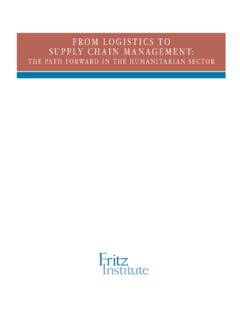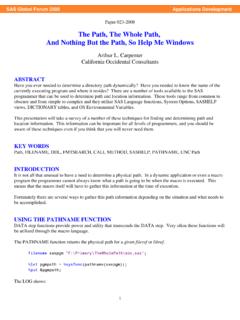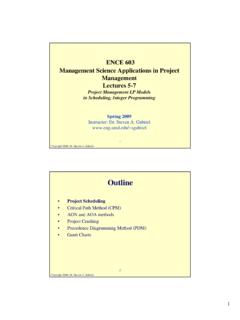Transcription of When is the Critical Path Not the Most Critical Path?
1 2008 AACE INTERNATIONAL TRANSACTIONS When is the Critical path Not the most Critical path ? Mr. Murray Woolf oday, 50 years after the Critical path method (CPM) was invented, there still is no universally accepted definition of the central term, Critical - path . Among the dozens of more obscure definitions, two conflicting definitions dominate Scheduling glossaries: the longest- path basis and the least-float basis. The problem goes much deeper than a lack of agreement on what should be the determining factor when identifying a schedule s Critical - path . A careful review of current scheduling literature shows that there is virtually no definition to be found for the underlying words path or Critical , as standalone terms of significance in their own right.
2 This paper challenges the conventional thinking, by proposing a new way to understand and use the term Critical - path . At stake is much more than a semantic discussion of terminology. Numerous surveys have confirmed that CPM schedules are used for two primary reasons: project management and dispute resolution. To support either use, the Critical - path must be identifiable in a consistent, objective, and defendable way. In claims, methods for proving delay, acceleration, and time impact center on a schedule s contemporaneous Critical - path . In project management, the main purpose of the schedule is to help prioritize daily activities, so that what is more Critical gets earlier and greater attention.
3 DEFINITIONAL CRITERIA Note that the word Critical is an adjective that characterizes the word path . A Critical path is distinguished from a near- Critical or non- Critical path . Because of its central importance, we will begin by understanding the root word, path . For, if we cannot agree on a path s composition, we certainly cannot agree on how to distinguish a Critical path from its non- Critical cousin. Accordingly, in this section, we will explore definitional criteria for three terms: path , Critical , and Critical - path . In the second section, we will consider a new paradigm for defining the term Critical path , one that accommodates the definitional criteria developed in this section. DEFINITIONAL CRITERIA FOR THE TERM, path We begin by turning to the American Heritage dictionary to appreciate the common meaning of the word, path .
4 The route or course along which something travels or moves. A road, way, or track made for a particular purpose. Unfortunately, these two general definitions provide little help. More useful, perhaps, is to picture a path through the woods, comprised of evenly spaced stepping stones. Would we consider such a path as being comprised only of the stones themselves, or would the path also include the cleared and leveled dirt between and alongside the stones? To answer this, we envision those same stones, but this time in the plant where they are manufactured. Without the surrounding leveled and cleared ground, the stones lose their context and no longer appear to be a path . From this observation, we realize that, implicit in the word path , are all of the components that, collectively, constitute a path , not just the stones themselves, even though they are the primary component.
5 T 2008 AACE INTERNATIONAL TRANSACTIONS We realize that it is important to identify all of the components that give the path its functionality, allowing those who travel on the path to reach their intended destination. In scheduling terms, this would include not just the activity itself, but also the relationships between the activities, date constraints that regulate work flow along a path , calendars that provide the temporal backdrop for work effort, and even software settings that affect the interpretation of work flow intentions and realities. Further, we must distinguish between (a) knowing that a relationship between two activities exists, and (b) appreciating the nature of that relationship. While activities can be related to one another in many different ways (common resource, geography, timing, work type, etc.)
6 , when seen as an element in defining the word, path , we are interested in the functional aspect of relationships. That is, our definition must describe how the activities relate to one another and to the ultimate terminus of the path . Both dictionary definitions seem to call for such a linkage. While made for a particular purpose is a more forceful requirement than along which something travels or moves, both reference a purpose for the path , and not just what might physically comprise a path . Because we believe that the definition for the term, path , should make reference to the path s point of terminus, as well as its point of origin, we are faced with this difficult question: Where does a path begin and end?
7 If we cannot define a path s starting or ending points, how can we begin to define the term, Critical - path . After exhaustive consideration, our studies led us to three possible options. For purposes of this paper, we assume that whatever condition(s) might define the start of a path , would also define the end of a path . Open Ends: We could say that a path begins where it has no predecessor activity, and it ends where it has no successor activity. This definition fully supports the longest path definition. Date Constraints: for this option, we assume that a start-no-earlier-than date constraint is imposed to the first activity in the schedule and that a finish-no-later-than date constraint is imposed to the last activity in the schedule.
8 This option says that a path spans between date , Total Float: We could say that a path can only have one total float value, and that the start and end of a path are identified by a change in total float values. We tested each option against a sample logic diagram, and then applied the two prevailing Critical - path definitions. We found that each option introduced problems we could not easily solve. Open Ends The immediate problem with the open end option is that it allows a single path to have multiple total float values along the way. This is problematic for two reasons: It makes the two prevailing definitions of Critical - path instantly incompatible. We see that the longest path cannot be least-float path , because the longest path has more than one total float , It further complicates the question of: with what schedule element should the total float value be associated?
9 We know that total float does not belong to a single activity. We have always thought it belonged to the path . And, But if a path has more than one total value along its length, then: with what schedule element should the total float value be associated? Date Constraints This option poses a different problem, for if there were more than two date constraints in the schedule, then we remove the absolute correlation between the longest path and the least-float path . Total Float This option has two immediate drawbacks. First, total float can change because of any number of factors, including date constraints, path length, software settings, calendars, and even the choice of relationship types (SS, FS, FF, SF).
10 With each subsequent schedule update, the total float values would change and, with them, the precise identify of the paths themselves. This would be as problematic as having activity identifiers changing with each subsequent update. Second, using this option, the path would no longer necessarily correlate with any particular completion milestone, let alone the project completion milestone. 2008 AACE INTERNATIONAL TRANSACTIONS path Segments Realizing that none of the obvious options came without complications, we partially solved the problem by creating a new term, path segment: A path segment is any series of connected activities that begins with either a date constraint or two or more predecessor activities, and ends with either a date constraint or two or more successor activities.
